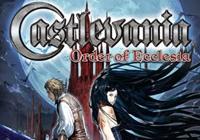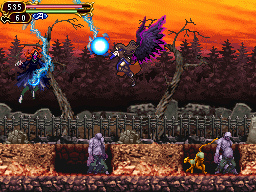Castlevania: Order of Ecclesia (Nintendo DS) Review
By Rudy Lavaux  04.01.2011
04.01.2011

The Castlevania series has come a long way over the years. It might be the series that has spanned the most platforms with the most completely unique games (unlike series such as Street Fighter, which has so many revisions of the same games that it’s ridiculous). Castlevania has seen a lot of evolutions over the years. Let's see how this third Nintendo DS installment compares to its predecessors.
A core feature to all Castlevania games is the story, and their place inside the series timeline. This episode takes place in the early 19th century, which would be after the events of Castlevania: Symphony of the Night and before the events of Castlevania: Circle of the Moon. You take the role of Shanoa, a woman who is part of a group of people called “The Order of Ecclesia”. This Order, and others with it, were created to help find ways to defeat Dracula should he awake again. Usually, the Belmont clan would be there to take care of the lord of all vampires, but their lineage disappeared from the surface of the world (supposedly sometime in the early 19th century), which lead to the creation of such Orders. The Order of Ecclesia came up with a set of three very powerful glyphs called “Dominus”. By fusing this set of glyphs with a human being, Dracula could be defeated. Our heroine, Shanoa, was chosen by the head of the Order, Barlowe, to become the host for Dominus.
So it was settled, and the ritual to make Shanoa absorb Dominus began. However Shanoa's best friend, apparently jealous that he wasn't chosen to become the vessel of Dominus, interrupts the ritual before it can be completed, and steals Dominus. However, interrupting this process before its completion has a dramatic effect on Shanoa, leaving her emotionless and without memories. Barlowe explains to the clueless Shanoa what has happened to her and she sets out to retrieve Dominus.
The story is well matched with the gameplay mechanics, as glyphs not only play a big role in the scenario, but also in how your character controls. Not unlike Castlevania: Aria of Sorrow and its sequel, you can equip different types of glyphs (in the Sorrow games, you equipped souls), which give you new ways of attacking your foes, but also new moves letting you access previously unreachable areas.

What's different though from the Sorrow games is how they're used. In previous Castlevania games, you would equip weapons for attacking, and the rest of what you could equip would only add an effect to your normal attacks or give you additional super attacks. In Order of Ecclesia, the glyphs you equip determine what kind of weapon Shanoa is equipped with (axes, scythes, magic beams, etc.), as well as her attack power. You can equip two attack glyphs, each assigned to the Y and X buttons, and one ability glyph, assigned to the R button. Your normal attacks consume Magic Points. Combining two different attack glyphs will give you different super attacks and combining two identical ones will give you a super version of your regular attack (a larger weapon, for example). These super attacks consume hearts instead of MP - and a lot of them.
This affects drastically the playstyle of this Castlevania, when compared to previous episodes. With your regular attacks quickly draining your MP, you will sooner or later run out of MP and become incapable of attacking when facing stronger enemies or bosses which require a huge amount of hits before they die. You then have to wait until you can attack again as your MP gauge refills automatically. The rate at which it fills depends on Shanoa's stats, though it's unclear which ones have an impact on it.
This brings us to talk about the difficulty. Out of the three DS episodes, Order of Ecclesia is arguably the hardest one, for the aforementioned reason. Since Konami now prevents you from spamming the enemy with attacks in hope that you'll drain its energy faster than it'll drain yours, you are forced to memorize your enemies attack patterns (just like you would have done in the first few episodes in the series). Normally, in other modern Castlevania games, you could always train a bit before facing a tough boss, gaining more Health Points and strength and making the battle easier. While you can still do that in Order of Ecclesia, it won't help you as much as in the past. This makes the boss battles more cleverly designed, as a lot of effort seems to have been put precisely in designing the boss moves patterns this time. Each boss then requires you to study its movements, as well as looking for its weak point, each of them being more vulnerable to a certain type of weapon.

Of course, the character growth system is still similar to previous Castlevania games. You gain experience points from defeating enemies, and your statistics increase as you gain levels from gathering those experience points, just as you would in most role-playing games. The structure of the game still uses the ‘Metroidvania’ style, which has become the rule in all recent 2D episodes. While exploring the game world you regularly encounter areas that you can't access until you get some new move or accessory that will allow you to reach it. Order of Ecclesia brings a new twist to the traditional formula in the form of a world map which splits the entire region, with the game taking place in smaller areas. Once you exit an area, you appear on the world map and can select the next one you want to enter, be it the nearest or the farthest one. This makes traveling inside the game a lot faster than before.
For a reason which I won't spoil here, all the inhabitants of the only village in the game have disappeared. It's up to Shanoa to find them all, scattered throughout the game. Each villager, once freed and returned to the village, will give quests for you to take on, yielding your character some rewards (money or rare pieces of equipment). You won't be able to complete all the quests right away. Some will require you to have access to certain zones which aren't reachable until late in the game. All quests aren't readily available at any time anyway: villagers may tell you they don't have anything to ask you at the moment, but might have later on in the game.
This episode, like its DS predecessor, has some online features as well. There's a race mode which lets you race against a friend, which is a bit pointless in my opinion. There's only three courses to choose from and finding someone willing to play this rather boring mode will prove difficult, especially since the game was released so long ago. The other online mode is shop mode, which is what you would expect. You can set up shop and sell your own items for other players to buy from you, and the other way round. The boss rush coop mode, which was the most interesting mode present in Portrait of Ruin, unfortunately has disappeared this time. The two modes available in online can also be used in local Wi-Fi.
Those of you possessing a Wii and the fighting-game spinoff to the Castlevania series, Castlevania Judgement, can also unlock some features in both games by connecting them wirelessly. I can't say anything regarding the unlockables in the Wii game, but I can say that those in the DS one can all be alternatively obtained by achieving something in the DS game itself, so you're not missing anything by not possessing the Wii game. Unlocking them will just prove to be much harder.

From a graphical standpoint, Order of Ecclesia is simply the best looking 2D Castlevania game ever made (not counting Harmony of Despair on Xbox Live Arcade). You have lots of highly detailed background elements as well as some 3D background elements which give the game world a better sense of depth. It must also be said that this game finally brings lots of new enemy designs, after seeing almost every previous 2D episode recycle the same ghouls, skeleton and other monster sprites from Akumajou Dracula X: Chi no Rondo for PC-Engine, released way back in 1993! These new enemies make this episode feel much more fresh than the other latest ones.
Ayami Kojima had stopped designing characters for Castlevania games released on Nintendo consoles after Aria of Sorrow for Game Boy Advance in 2003. Indeed, Dawn of Sorrow and Portrait of Ruin both had more anime-style character designs instead. This game brings back a more mature character design to the series on Nintendo's handhelds, thanks to Masaki Hirooka's work (who had previously worked on Sonic and the Secret Rings, and later designed characters for Suikoden Tierkreis on Nintendo DS and ESPgaluda II on Xbox 360). This new design is, in my humble opinion, the best alternative Konami could get short of having Ayami Kojima come back to work on the series.
Finally, this game also has a lot going for it in the sound department. You can choose to hear the Japanese or English voices at any time during the game from the sound menu (as opposed to the option in Portrait of Ruin to hold down the L button upon selecting a save file). The sound effects are cool and the music is superb from beginning to end, with the occasional remix of old tunes from past episodes such as “Riddle” from Castlevania III: Dracula's Curse or “Tower of Dolls” from the Sharp X68000 episode Akumajou Dracula. Actually you can unlock the whole soundtrack from the first NES Castlevania in the form of vinyl records which you can listen to while you're playing, provided that you can find them scattered throughout the game.

Cubed3 Rating
Exceptional - Gold Award

Any DS owner who is into the Castlevania series and/or is a fan of the action/platform/RPG formula should get this game. It's not only one of the best episodes in the series, but also one of the best games released for the DS; impressive given the amount of titles released on our favorite handheld. The story, while being mostly a pretext for the action, like in all Castlevania games, is still interesting enough to keep you hooked until the end. If you haven't already, get this game. You know you want it.

![]() 9/10
9/10
![]() 8/10
(1 Votes)
8/10
(1 Votes)
 Out now
Out now  Out now
Out now  Out now
Out now  Out now
Out now Comments
Comments are currently disabled

 Sign In
Sign In Game Details
Game Details Subscribe to this topic
Subscribe to this topic Features
Features






 Top
Top

